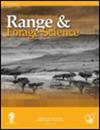埃塞俄比亚西部半湿润农业生态条件下不同旱季收获管理对纳皮尔草产量和品质的响应
IF 1.9
4区 环境科学与生态学
Q3 ECOLOGY
引用次数: 1
摘要
在2015年、2016年和2017年进行了3 × 2因子研究,以评估旱季刈割管理对纳匹尔草饲料产量和品质的影响。试验采用3个收获期(11月、1月和3月)和2个割茬高度(20和30 cm)。结果表明,2015年和2016年的干物质产量和叶茎比记录均显著高于2017年。2017年的耕作业绩低于2015年和2016年。DM产量最高的记录出现在3月份的收获季节。然而,在11月收获时,叶茎比更大。另外,3月和11月的耕作表现好于1月。总体而言,在30 cm处扦插比在20 cm处扦插能获得更好的DM产量和分蘖数。试验年限和刈割高度对粗蛋白质(CP)、中性洗涤纤维(NDF)和酸性洗涤纤维(ADF)均无影响。然而,收获时间对CP、NDF和ADF有影响。由于11月CP大于3月,且NDF和ADF水平均高于3月,建议在11月切割30厘米。本文章由计算机程序翻译,如有差异,请以英文原文为准。
Forage yield and quality response of Napier grass (Cenchrus purpureus) to different dry season harvesting management under the subhumid agroecology of western Ethiopia
A 3 × 2 factorial study was conducted in 2015, 2016 and 2017, to assess the impact of dry season cutting management on fodder yield and quality of Napier grass. Three harvesting times (November, January and March) and two stubble- cutting heights (20 and 30 cm) were used in the study. The results revealed that the dry matter (DM) yield and leaf:stem ratio records in 2015 and 2016 were much higher than in 2017. Tilling performance was lower in 2017 than in 2015 and 2016. The highest DM yields were recorded during harvesting time in March. In the November harvest, however, the leaf:stem ratio was greater. In addition, tilling performance was better in March and November than it was in January. Overall, cutting at a height of 30 cm resulted in better DM yield and tiller numbers than cutting at a height of 20 cm. Experimental years and cutting height did not affect crude protein (CP), neutral detergent fibre (NDF) or acid detergent fibre (ADF). Harvesting times did, however, affect CP, NDF and ADF. As CP was greater in November than in March and both NDF and ADF levels were higher in March, cutting in November at 30 cm is advised.
求助全文
通过发布文献求助,成功后即可免费获取论文全文。
去求助
来源期刊

African Journal of Range & Forage Science
ECOLOGY-ENVIRONMENTAL SCIENCES
CiteScore
4.00
自引率
14.30%
发文量
35
审稿时长
>12 weeks
期刊介绍:
The African Journal of Range & Forage Science is the leading rangeland and pastoral journal in Africa. The Journal is dedicated to publishing quality original material that advances rangeland ecology and pasture management. The journal aims to publish research of international importance from any region, but as an African journal, we are particularly interested in research from Africa and relevant to the continent. The Journal promotes both science and its application and authors are encouraged to explicitly identify the practical implications of their work. Peer-reviewed research papers and research notes deal primarily with all aspects of rangeland and pasture ecology and management, including the ecophysiology and biogeochemistry of rangelands and pastures, terrestrial plant–herbivore interactions (both domestic and wild), rangeland assessment and monitoring, effects of climate change on rangelands, rangeland and pasture management, rangeland rehabilitation, ecosystem services in support of production, conservation and biodiversity goals, and the identification and development of intensive and semi-intensive pasture and forage resources to meet livestock production needs. Articles highlighting transdisciplinary linkages among biophysical and social sciences that support management, policy and societal values are particularly encouraged. The Journal includes relevant book reviews and invited perspectives that contribute to the development of range and forage science. Letters to the editor that debate issues raised in the Journal are acceptable. The African Journal of Range & Forage Science is the official journal of the Grassland Society of Southern Africa.
 求助内容:
求助内容: 应助结果提醒方式:
应助结果提醒方式:


